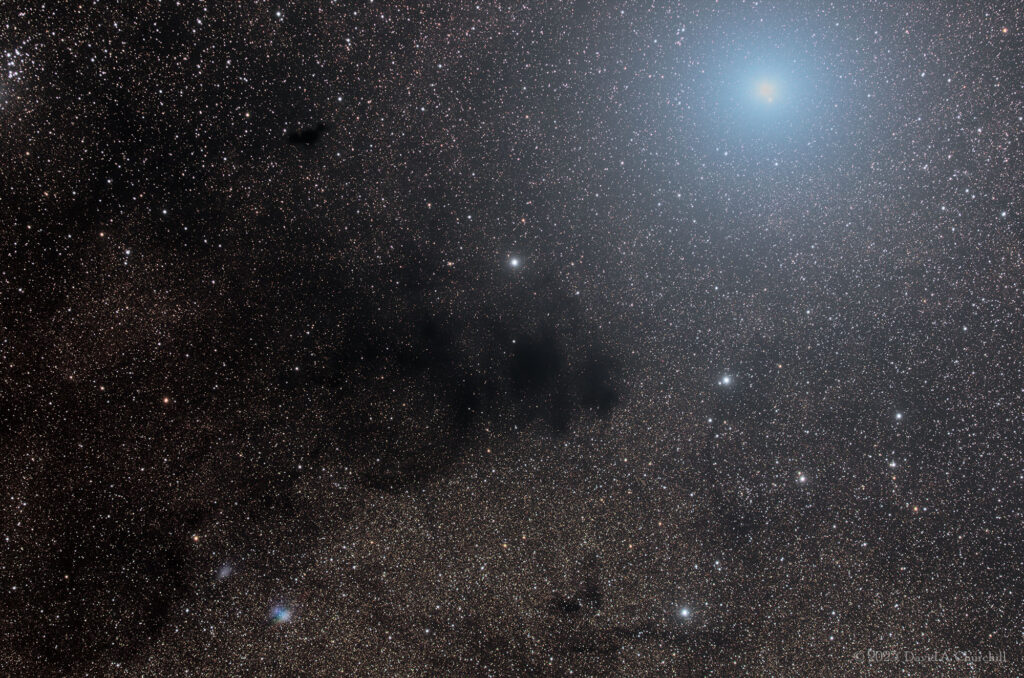C099 Coalsack Nebula
Western Edge of the Coalsack Nebula, Dark Nebula. Crux
- Description
- Technical
- Links
The Coalsack Nebula (Southern Coalsack, or simply the Coalsack) is a dark nebula, which is visible to the naked eye as a dark patch obscuring part of the Milky Way east of Acrux (Alpha Crucis) in the constellation of Crux. This image shows the western limit of the Coalsack Nebula, with the bright star Acrux at upper right.
The Coalsack Nebula covers nearly 7° by 5° and extends into the neighboring constellations Centaurus and Musca. The first observation was reported by Vicente Yáñez Pinzón in 1499. It was named “il Canopo fosco” (the dark Canopus) by Amerigo Vespucci and was also called “Macula Magellani” (Magellan’s Spot) or “Black Magellanic Cloud” in opposition to the Magellanic Clouds.
In Australian Aboriginal astronomy, the Coalsack forms the head of the emu in the sky in several Aboriginal cultures. Amongst the Wardaman people, it is said to be the head and shoulders of a law-man watching the people to ensure they do not break traditional law. According to a legend reported by W. E. Harney, this being is called Utdjungon and only adherence to the tribal law by surviving tribe members could prevent him from destroying the world with a fiery star. There is also a reference by Gaiarbau (1880) regarding the coalsacks replicating bora rings on Earth. These astronomical sites allowed the spirits to continue ceremony similar to their human counterparts on Earth. As bora grounds are generally located on the compass points north–south, the southern coal sack indicates the ceremonial ring.
The Coalsack Nebula covers nearly 7° by 5° and extends into the neighboring constellations Centaurus and Musca. The first observation was reported by Vicente Yáñez Pinzón in 1499. It was named “il Canopo fosco” (the dark Canopus) by Amerigo Vespucci and was also called “Macula Magellani” (Magellan’s Spot) or “Black Magellanic Cloud” in opposition to the Magellanic Clouds.
In Australian Aboriginal astronomy, the Coalsack forms the head of the emu in the sky in several Aboriginal cultures. Amongst the Wardaman people, it is said to be the head and shoulders of a law-man watching the people to ensure they do not break traditional law. According to a legend reported by W. E. Harney, this being is called Utdjungon and only adherence to the tribal law by surviving tribe members could prevent him from destroying the world with a fiery star. There is also a reference by Gaiarbau (1880) regarding the coalsacks replicating bora rings on Earth. These astronomical sites allowed the spirits to continue ceremony similar to their human counterparts on Earth. As bora grounds are generally located on the compass points north–south, the southern coal sack indicates the ceremonial ring.
Telescope: Astro Physics 155EDF (TCC) f5.4
Mount: Astro Physics 1600GTO
Camera: FLI PL29050 / CFW2-7
Guider: Agena Starguide II / ZWO ASI178MM
Filters: Astrodon II 50mm LRGB
L: 39×5 mins = 195 mins, R: 24×5 mins = 120 mins, G: 32×5 mins = 160 mins, B: 24×5 mins = 120 mins
Total Imaging Time: 9h 55m
Data Imaged remotely over 5 nights during January & February 2023.
Imaged from Observatorio El Sauce, Chile, in partnership with Fred Espenak.
Data acquisition & Processing by David Churchill.
None

